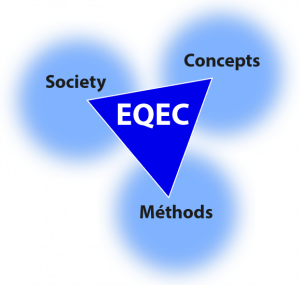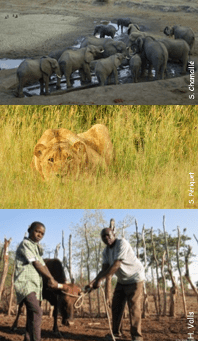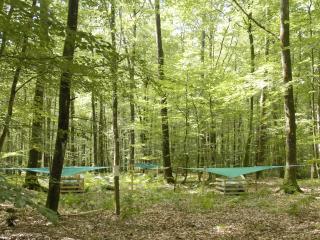Quantitative and Evolutionary Ecology of Communities Group
Members

Doctorante
UCBL

Professeure des universités
VetAgro-Sup
Tel: 33 04 72 43 27 56

Directeur de recherche
CNRS
Tel: 33 04 72 43 27 57

Doctorant
UCBL
Tel: 04 72 44 81 42

Doctorant
CNRS
Tel: 04 72 44 81 42
Doctorant
VetAgro-Sup

Post-doc
CNRS

Maître de conférences
UCBL
Tel: 04 72 44 81 42


Professeur des universités
UCBL
Tel: 33 04 72 43 27 56

Professeur des universités
UCBL

Directeur de recherche
CNRS
Tel: 33 04 72 43 27 56

Maîtresse de conférences
UCBL
Tel: 33 04 72 43 29 02
Maître de conférences
UCBL
Tel: 33 04 72 43 29 02

Our research activities, focused on interspecific interactions (community ecology), aim to better understand the ecological and evolutionary processes structuring species assemblages and biodiversity at different temporal and spatial scales. Our team addresses these major issues using contrasting biological models (communities of large African mammals, insects, microbiota, plants) from 3 complementary angles:
- Our work is strongly anchored in the conceptual framework of evolutionary biology by studying (i) the diversity of adaptive responses implemented by organisms to selective pressures in their environment, (ii) their consequences on population demography and ultimately (iii) the dynamics and composition of species communities.
- Our research is closely linked to societal issues of biodiversity conservation and management by integrating both the functioning of socio-ecological systems and the context of climate change. We conduct experimental studies, manage and ensure the long-term monitoring of several community observation networks.
- Methodological issues also occupy a central place in our team, with the development of new tools for statistical processing and modeling of ecological data. This activity leads to the development of methods and software that we develop and distribute freely.
Research programs

Functioning of African savanna communities
The Hwange LTSER (Long-Term Socio-Ecological Research site in Zimbabwe hosts a long-term interdisciplinary research program that focuses on the functioning of plant and animal communities within the Hwange National Park and the interactions between this protected area and humans living in its periphery. Based on this program, three axes are developed: (1) studying the population dynamics of elephants, exploring their impact and that of management policies on the socio-ecosystem functioning; (2) Understanding the extent to which interactions within and between trophic levels are sensitive to management actions (e.g. sport hunting, water management) and climate change; (3) Decoding human ecology and human-wildlife coexistence mechanisms towards integrated conservation and sustainable functioning of the socio-ecosystem. This research is complemented by more recent works in the Hluhluwe-iMfolozi Park and in the Madikwe reserve in South Africa, which focus on the role of environmental conditions on the hunting success of large African carnivores. We work in close collaboration with the IRL (International Research Lab) Rehabs.
Involved group members : Alice Bernard, Laura Lacomme, Aïssa Morin, Lisa Nicvert, Elie Pedarros, Yolan Richard, Marion Valeix*

Masting and the community dynamics of seed consumers
Masting is a reproductive strategy often encountered in perennial plants, characterized by fructifications highly fluctuating in time and being synchronized at the population level. The seeds produced that way constitute a pulsed resource with a strong impact on the eco-evolutionary dynamics of seed-consuming communities and forest regeneration. Our lack of knowledge of this system still impedes our understanding of the dynamics of temperate forest ecosystems and its future in the context of climate change. Our work carried out on oak forests aims to better understand (i) the proximal causes of masting, (ii) the mechanisms underlying the coexistence of species competing for such highly fluctuating resource and (iii) the co-evolution of consumer exploitation strategies for the fluctuating resource and forest tree fruiting strategies. On the basis of the results obtained, scenarii will be proposed on the future of forest regeneration under climate change, that may serve forest management.
Involved group members : Marie-Claude Bel-Venner*, Emilie Fleurot, Léa Keurinck, Jean Lobry, Samuel Venner

The spread of antibiotic resistance genes in bacteria
Antibiotic resistance is recognized as one of the greatest current threats to human health, and the mobile genetic elements (MGEs) that circulate in bacterial populations and communities are the main vehicles. To understand the dynamics and diversity of MGEs in bacterial pangenomes and the emergence of antibiotic resistance genes, we propose to go beyond the framework of conventional genomics by considering pangenomes as complex ecological communities. In the Ab-One program, we mobilize the concepts and tools developed in community ecology based on an integrative approach (monitoring of bacterial populations/communities evolving in contrasting environments -One-Health approaches-, pan-genomic analyses, experimentation in molecular and cellular microbiology, mathematical modelling). This program is currently focused on the dynamics of MGEs in Acinetobacter baumannii, an antibiotic-resistant microorganism classified as a priority by the WHO. Other more general approaches will illustrate the relevance of this new conceptual framework to understand the dynamics and diversity of MGEs in bacterial pangenomes. This program, co-piloted by our team and a team from CIRI (Horigene) involves the participation of 9 organizations (6 from Lyon -LBBE, CIRI, MMSB, HCL, LEM, VetAgro Sup-, Institut Pasteur (Paris), LMGM (Toulouse ), Robert Koch Institute (Germany)).
Involved group members : Stéphane Dray, Rémi Tuffet, Samuel Venner*

Statistical analysis of ecological data
Understanding the structure and dynamics of species assemblages, and the processes behind them, requires collecting data that are becoming increasingly complex owing to the sophisticated technological developments made available for their acquisition (e.g. GPS, loggers, satellite imagery, molecular data). We are developing new methods for analysing such data, that provide new insights into the ecological processes at work in communities. Multivariate analysis methods allow the analysis of spatial structures, accounting for various information on species (functional traits, morphology, phylogeny), the spatio-temporal variation of species-environment relationships or the multifaceted perception of the protected human-environment relationship. We also model multi-'omics' dose-response data within communities in order to better understand the Adverse Outcome Pathway (AOP) and to better appreciate the risks to the environment. These methodological innovations are made available to the scientific community through the development, distribution and maintenance of software (libraries for the R language: ade4, adegraphics, adephylo, ade4TkGUI, nlstools, fitdistrplus, DRomics, seqinr).
Involved group members: Marie Laure Delignette-Muller, Stéphane Dray*, Jean Lobry, Jean Thioulouse.
Publications
Display of 391 to 420 publications on 666 in total
Diversity, Geographic Distribution, and Habitat-Specific Variations of Microbiota in Natural Populations of the Chicken Mite, Dermanyssus gallinae
Journal of Medical Entomology . 48 ( 4 ) : 788-796
DOI: 10.1603/ME10113
Journal article
see the publicationNurse shrubs increased the early growth of Cupressus seedling by enhancing belowground mutualism ans doil microbial activity
Soil Biology and Biochemistry . 43 ( 10 ) : 2160-2168
Journal article
see the publicationBiogeographical patterns of soil molecular microbial biomass as influenced by soil characteristics and management
Global Ecology and Biogeography . 20 : 641-652
Journal article
see the publicationSIMULTANEOUS ANALYSIS OF A SEQUENCE OF PAIRED ECOLOGICAL TABLES: A COMPARISON OF SEVERAL METHODS
Annals of Applied Statistics . 5 ( 4 ) : 2300-2325
DOI: 10.1214/10-AOAS372
Journal article
see the publicationBayesian modelling of daphnid responses to time-varying cadmium exposure in laboratory aquatic microcosms
Ecotoxicology and Environmental Safety . 74 ( 4 ) : 693-702
Journal article
see the publicationThe importance of incorporating age and sex when backcalculating length in bullhead Cottus gobio
Journal of Fish Biology . 78 : 1492-1507
Journal article
see the publicationThe Nile monitor (Varanus niloticus; Squamata: Varanidae) as a sentinel species for lead and cadmium contamination in sub-Saharan wetlands.
Science of the Total Environment . 409 : 4735-4745
Journal article
see the publicationBayesian modeling of Clostridium perfringens growth in beef-in-sauce products
Food Microbiology . 28 : 311-320
Journal article
see the publicationEstimating the Number of Contributors to Forensic DNA Mixtures: Does Maximum Likelihood Perform Better Than Maximum Allele Count?
Journal of Forensic Sciences . 56 ( 1 ) : 23-28
Journal article
see the publicationBiogeography of soil microbial communities: a review and a description of the ongoing french national initiative
Sustainable Agriculture Volume 2 . 978-94-007-0393-3 : 857-865
Book chapter
see the publicationHow can ecological status be summarized for an operational Pressures/States model ?
EGU (European Geosciences Union) General Assembly 2011 . : 1
Poster
see the publicationRelationships between species feeding traits and environmental conditions in fish communities: a three-matrix approach
Ecological Applications . 21 ( 2 ) : 363-377
DOI: 10.1890/09-2178.1
Journal article
see the publicationIdentification at the larval stage of four Curculio species coexisting on oak trees using PCR-RFLP
Entomologia Experimentalis et Applicata . 138 : 77-82
Journal article
see the publicationCoexistence of Insect Species competing for a pulsed resource: toward a unified theory of biodiversity in fluctuating environments
PLoS ONE . 6 ( 3 ) : e18039
Journal article
see the publicationA New Perspective on the Dunnett Procedure: Filling the Gap Between Noec/Loec and Ecx Concepts
Environmental Toxicology and Chemistry . 30 : 2888-2891
DOI: 10.1002/etc.686
Journal article
see the publicationAn accept-and-reject algorithm to determine performance objectives that comply with a food safety objective
7th International Conference on Predictive Modelling of Food Quality and Safety .
Conference paper
see the publicationA new perspective about Moran's Coefficient: Spatial autocorrelation as a linear regression problem
Geographical Analysis . 43 : 127-141
Journal article
see the publicationRevisiting Guerry's data: introducing spatial constraints in multivariate analysis.
Annals of Applied Statistics . 5 ( 4 ) : 2278-2299
DOI: 10.1214/10-AOAS356
Journal article
see the publicationBiogeographical patterns of soil molecular microbial biomass
Ecology of soil microorganisms : microbes as important drivers of soil processes . : 1 p.
Conference paper
see the publicationDiversity Geographic Distribution and Habitat-Specific Variations of Microbiota in Natural Populations of the Chicken Mite Dermanyssus gallinae
Journal of Medical Entomology . 48 : 788-796
Journal article
see the publicationInsertion Sequences as Highly Resolutive Genomic Markers for Sequence Type 1 Legionella pneumophila Paris
Journal of Clinical Microbiology . 49 ( 1 ) : 315-324
DOI: 10.1128/JCM.01261-10
Journal article
see the publicationSoil fungal communities ecology: a biogeographical approach
Ecology of soil Microorganisms Conference . : 1 p.
Conference paper
see the publicationContribution à l'étude des communautés d'adventices des culture du secteur phytogéographique oranais (Nord-ouest algérien) : aspects botanique, agronomique et phyto-écologique
AFPP - 21e Conférence du COLUMA - Journées internationales sur la lutte contre les mauvaises herbes . : 1-10
Conference paper
see the publicationCreationist conceptions of primary and secondary school teachers in nineteen countries
Contemporary Science Education Research: International Perspectives . 9786053640318 : 447-452
Book chapter
see the publicationBiogeographical patterns of soil microbial communities at the scale of French metropolitan territory
13. International Symposium on Microbial Ecology ISME 13 . : 1 p.
Conference paper
see the publicationBiogeography of soil microbial communities: a review and a description of the ongoing french national initiative
Agronomy for Sustainable Development . 30 ( 2 ) : 359-365
DOI: 10.1051/agro/2009033
Journal article
see the publicationMake Love Not War: When Should Less Competitive Males Choose Low-Quality but Defendable Females?
The American Naturalist . 175(6) : 650-661
Journal article
see the publicationAnalyse de la distribution des titres observés pour déterminer un seuil de positivité d’un test ELISA
Réunion annuelle du groupe « Tiques et Maladies Transmises » du « Réseau Ecologie Interactions Durable » (REID) . : 10 slides
Conference paper
see the publicationadephylo: new tools for investigating the phylogenetic signal in biological traits
Bioinformatics . 26 ( 15 ) : 1907-1909
Journal article
see the publicationThe exploratory analysis of autocorrelation in animal-movement studies
Ecological Research . 25 ( 3 ) : 673-681
Journal article
see the publication
You also, comment on this article